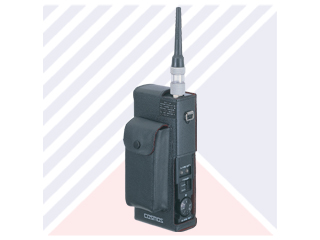
|
XP 702The Cosmos model XP-702S is extremely sensitively used not only by the gas but also by many other branches of industry where combustible gases or vapoures are used It is a unique type of detector which opens up a new concept of gas leakage detection. The XP-702S easily and quickly locates leaks in pipes and fittings where conventional methods such as soap solutions are impracticable. The sensitivity is high enough to test above ground for leaks in underground pipelines. This light and compact instrument is very convenient to use and affords considerable reduction in operator fatigue, labour time and cost |
Features
- Much more sensitive than soap solutions.
- Sensitive enough for above ground leak test.
- Faster and more convenient than conventional techniques.
- Hand-held portable with automatic pump.
- Compact and Lightweight.
- Simple to operate.
- Long sensor life.
- Ruggedly constructed.
DETECTS VARIOUS GASES: It can not only detect most combustible gases and vapours (including catalyst poisoning gases such as hydrogen sulphide, methyl chloride and methyl bromide) but also the non-combustible Freon R-22.
PRINCIPLES : The detection principle is two terminal type sintered semiconductor gas sensor with very low power drain, developed by Cosmos. This new type of sensor enables very low concentrations of a variety of gases to be detected.
OPERATION: The sample is drawn from a search probe automatically and continuously by an internal extremely low power drain micropump, passed over the sensor and exhausted to atmosphere. This automatic sampling method with the small size and light weight of the instrument allows normal work operations to be carried out with one free hand.
An intermittent tone sounds and an LED lamp flashes if a gas leak is detected, and a frequency of the signals will increase as a source of the leak is approached. An LED power pilot lamp goes out when batteries require replacement. An earphone jack is provided so that an earphone can be used where noise in the area to be tested obscures the tone signal. The tone signal can be silenced with a buzzer -off switch when it is a nuisance.
PROBES: A variety of search probes are available as accessories for use in locating leaks according to locations to be tested.
Special Model
Model XP-702S-A - This model is furnished with sensitivity calibration for two types of gas. A changeover switch selects the desired calibration of the two. It is usually used by an industry which supplies or uses two major types of gas, for example Natural gas and manufactured gas, or natural gas and LP gas.
When ordering XP-702S-A, please specify the two types of gas for which calibration is required.
Specifications
|
Detection Principle: |
Two terminal type sintered semiconductor gas sensor with very low power drain. |
|
|
Gases Detected |
Most combustible gases and vapours including catalystic poisoning gases such as hydrogen sulphied, methyl chloride, methyl bromide. Vinyl chloride monomer etc. and also the non-combustible freon R-22. When ordering, please specify the type of gas for which calibration is required. |
|
|
Minimum Detectable Leak Rate: |
3.3 X 10-5 atm. CC/sec.* |
|
|
Minimum Detectable Concentration: |
10ppm or less of gas used for calibration. |
|
|
Alarm style: |
Intermittent tone and flashing lamp with frequency proportional to gas concentration. |
|
|
Response Velocity: |
Max. 3 Seconds. |
|
|
Power Supply: |
4 X UM-3 (AA Size) cells. |
|
|
Battery life: |
3 hours for continuous use with standard dry cell batteries. |
|
|
Intrinsic Safety: |
Id2G3 Certificate no. 32184 (intrinsic safety is not certified if instrument is calibrated for ammonia). |
|
|
Operation Temperature: |
-20° C to + 50° C (-4° F to +122° F). |
|
|
Dimensions: |
155mm X 68mm X 32mm (6.2" X 2.7" X 1.3"). |
|
|
Weight: |
400gr. (14 OZ.). |
|
|
Accessories Supplied: 6(, 7), 8) are not supplied with XP-702S-A |
|
|
|
Optional Accessories: |
|
|
|
* Atm. Cc/sec. is a unit to show an amount of gas leakage in one atmosphere. It is known that the limit of gas detecting capacity by use of soap solutions is 1.3 X 10-1 cc/sec. |
||